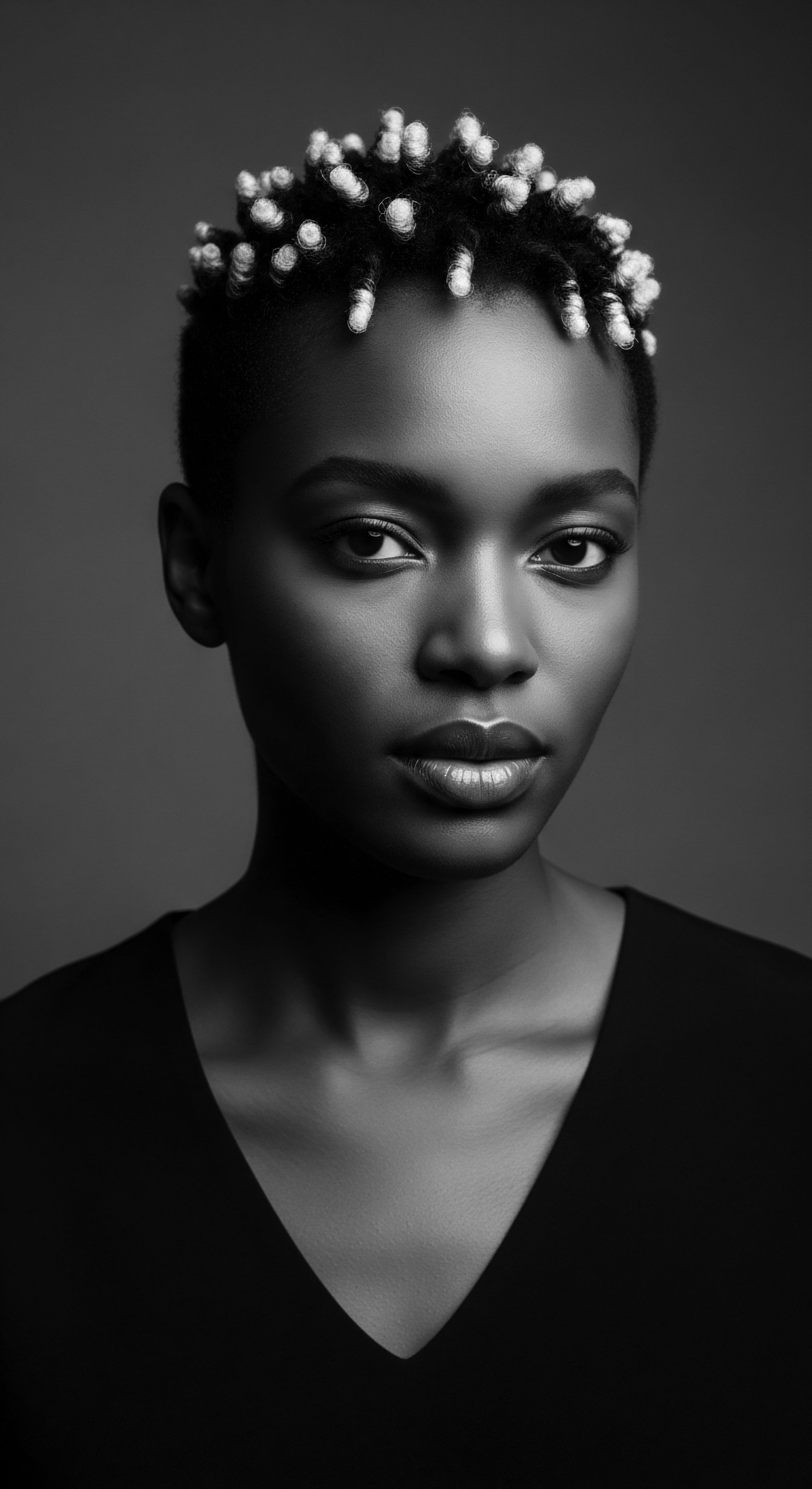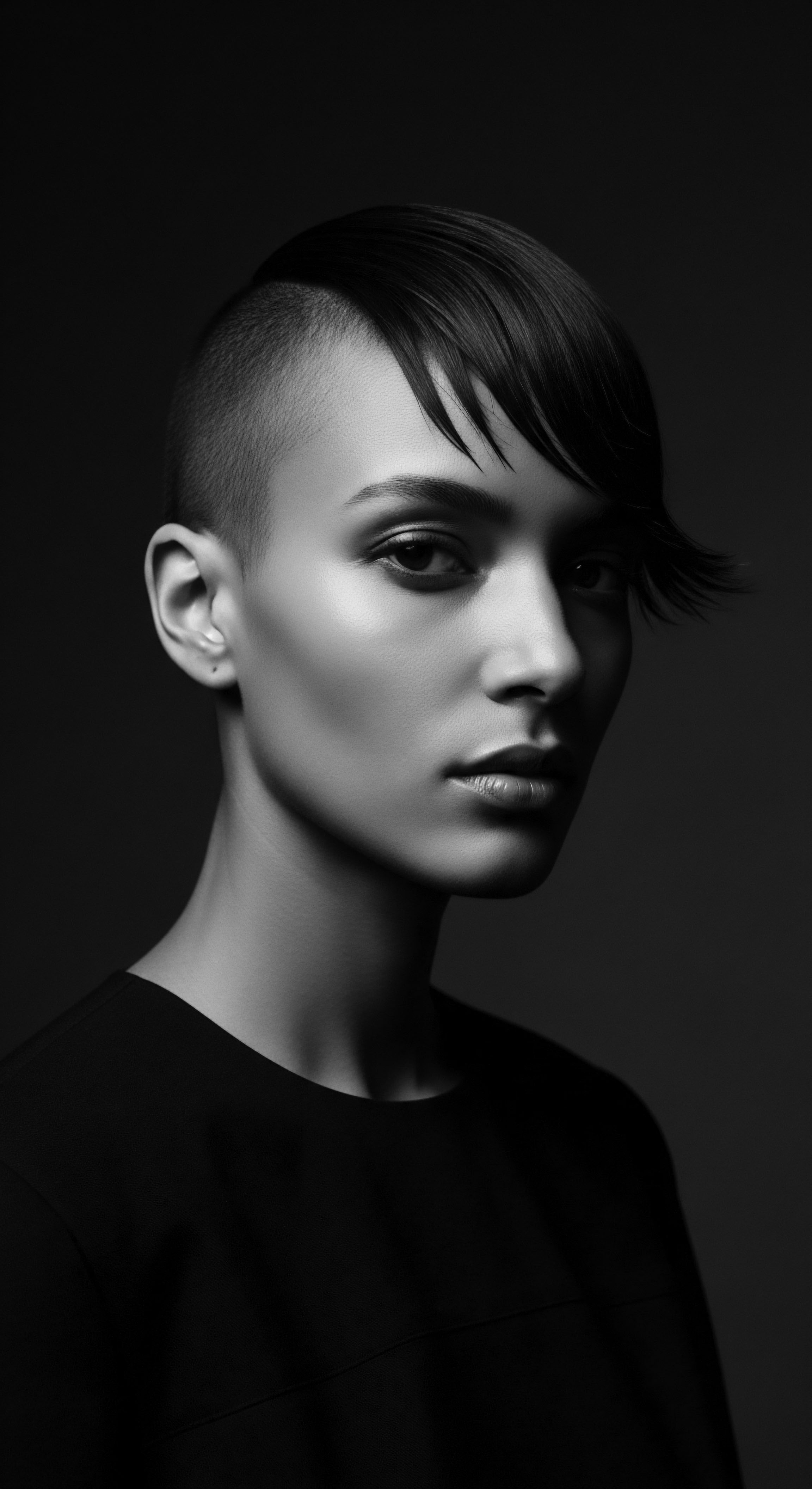
Roots
Have you ever paused to consider the whispers held within each coil, each curl, each strand that graces your crown? The hair upon our heads, especially textured hair, is not simply a biological marvel; it is a profound historical archive, a living testament to journeys, adaptations, and resilience across countless generations. It carries the ancestral echoes of wind-swept savannas, sun-drenched forests, and humid coastal plains.
Our hair care heritage, particularly within Black and mixed-race communities, is not merely a collection of beauty rituals. It is a direct dialogue with the very environments our forebears navigated.
To truly appreciate the intricate dance between our strands and their storied past, we must look to the elemental forces that shaped human existence. How did the relentless sun, the biting dryness, the pervasive dust, or the saturating humidity of specific geographies mold the ways our ancestors cared for their hair? This inquiry demands we move beyond superficial aesthetics and journey into the very cellular architecture of textured hair, understanding its inherent design as a response to the world around it. We are speaking here of more than conditioning; we speak of survival, of identity, and of ingenious adaptation.

Hair Anatomy and Environmental Influence
The unique helical structure of textured hair, with its characteristic bends and twists, positions it distinctively within the human biological spectrum. This shape, governed by the distribution of keratin proteins and the shape of the follicle, lends itself to specific properties. In arid climates, for instance, a tighter curl pattern can create a natural protective barrier, insulating the scalp from harsh ultraviolet radiation and reducing the direct surface area exposed to moisture-depleting winds. This intrinsic morphology meant different needs and, thus, different care approaches.
Consider the early human migrations across continents. As populations moved from one environmental zone to another, their hair, over millennia, underwent subtle yet significant adaptations. The very porosity of our hair – its ability to absorb and retain moisture – can be seen through this ancient lens.
Hair that thrived in humid equatorial regions might possess a naturally higher porosity, readily accepting moisture from the air, while hair in dry, desert environments might have evolved a tighter cuticle to minimize moisture loss. These are not merely genetic coincidences; they are environmental imprints, woven into the very fabric of our hair.

How Did Early Climates Shape Hair Structure?
Early climates profoundly influenced the development of hair structures. In regions with intense solar radiation, darker hair and tighter curl patterns would have offered superior protection against UV damage to the scalp and provided a form of thermal insulation. Conversely, in colder climates, straighter hair might have allowed for quicker drying after exposure to moisture, reducing the risk of hypothermia. This biological interplay created a diverse spectrum of hair types across humanity.
The density of hair follicles, too, has a story to tell. A greater density of hair on the scalp can offer more comprehensive protection, a biological umbrella against environmental extremes. This protective aspect of hair was paramount in ancestral survival, making its care not just a matter of adornment but of health and well-being. The earliest hair care practices, then, were born from this understanding, an intuitive knowing of what the environment demanded of the body and its crown.
Our hair’s unique helix carries ancestral echoes, a living archive shaped by the environments our forebears navigated.

The First Lexicon of Care
The earliest forms of hair care were pragmatic, rooted in available resources and environmental imperatives. Indigenous communities across Africa, the Caribbean, and the Americas developed sophisticated practices using what nature provided. The term for hair in many African languages often carries connotations of strength, wisdom, or a connection to the spiritual realm, underscoring its profound cultural and practical significance.
These terms were not isolated; they were part of a larger lexicon that described not only hair types but also the plants, minerals, and techniques used for its care. The very act of naming these practices and ingredients solidified their place within the cultural heritage.
- Ukuchela ❉ A term from some Southern African languages, possibly referring to the act of anointing hair with oils or fats.
- Tukus ❉ From the Fulani language, often used to describe braided styles, especially those with intricate patterns.
- Chebe ❉ From the Basara language in Chad, referring to the powdered plant mixture used to protect and strengthen hair.
These were not merely words; they were mnemonic devices, carrying the instructions and wisdom of generations, a vibrant glossary of ancestral hair knowledge. They remind us that the conversation around textured hair and its care began long before modern science, driven by acute observation and profound reverence for the body’s natural state.

Ritual
The elemental forces of earth, wind, fire, and water did not merely shape the genetic blueprint of our hair; they meticulously sculpted the rituals of its care. These ancestral practices, far from being simplistic, embodied a sophisticated understanding of environmental interaction, a deep intelligence about how to protect, nourish, and adorn textured hair in diverse climatic zones. The shift from rudimentary care to elaborate ritual marked a pivotal moment in the heritage of hair.
Consider the searing heat of the Sahel or the humid embrace of the West African rainforest. Each climate presented distinct challenges to hair health, compelling communities to innovate. From these environmental pressures arose a rich tapestry of hair care traditions, passed down through the gentle, knowing hands of mothers, aunties, and village elders. These were not random acts; they were calculated, often sacred, responses to the dictates of the land.

Protective Hairstyles and Environmental Adaptation
Protective styling, a cornerstone of textured hair care today, finds its deepest roots in ancestral practices born from environmental necessity. In regions characterized by intense sun, dust, and arid winds, tightly coiled or braided styles served as a literal shield. Hair tucked away in braids, twists, or elaborate up-dos was less exposed to direct sunlight, reducing UV damage and preventing moisture loss.
The prevalence of cornrows, dreadlocks, and intricate coiling patterns across various African cultures speaks volumes. These styles were not solely for aesthetic appeal; they were functional adaptations. They minimized tangling from dust and wind, distributed tension evenly, and allowed for the application of protective salves and oils directly to the scalp, where environmental stressors often hit hardest.
This heritage of protective styling is particularly evident in the Himba people of Namibia. Their iconic “otjize” paste, made from butterfat, ochre, and aromatic resin from the omuzumba tree, offers a compelling case study. Applied regularly, it served as a powerful sunscreen for both hair and skin, protecting against the intense desert sun and preventing dryness.
This practice, meticulously maintained over centuries, is a direct response to a harsh environment, transforming care into a cultural signature. (Morrow, 1973).

How Did Traditional Practices Shield Hair from the Elements?
Traditional practices effectively shielded hair from the elements through ingenious methods. Elaborate braiding patterns, often coated with natural oils and clays, created a physical barrier against dust, wind, and sun. Head coverings, too, were integral, providing an additional layer of protection and modesty. These methods were collective wisdom, perfected over generations.
In humid environments, where excessive moisture could lead to frizz and fungal growth, specific cleansing and drying techniques would have been employed, alongside lightweight applications of plant extracts that deterred microbial growth. The choice of styling tool also reflected these environmental considerations. Combs carved from wood, for instance, might have been preferred over harsher materials to minimize breakage on vulnerable, climate-stressed strands.

Ingredients from the Earth
The landscape itself became the pharmacy for hair care. The indigenous plants, minerals, and animal products found in a specific locale dictated the available ingredients and, consequently, the efficacy of traditional formulations. From the shea butter trees of West Africa to the desert dates of the Sahel, each botanical offering played a role in ancestral hair health.
The preparation of these ingredients was often a ritual in itself. Grinding herbs, infusing oils with botanicals over slow heat, or mixing clays with water—these were not just utilitarian tasks. They were acts of connection to the earth, imbuing the concoctions with purpose and reverence.
- Shea Butter ❉ From the shea tree (Vitellaria paradoxa) in West Africa, used for intense moisture and scalp health, especially in dry seasons.
- African Black Soap ❉ Crafted from the ash of plantain peels, cocoa pods, and palm leaves, a powerful cleanser for scalp and hair.
- Chebe Powder ❉ A fortifying mixture from Chad, primarily derived from Croton Gratissimus, known for its moisture retention properties.
These ingredients were chosen not arbitrarily but based on generations of empirical observation. Their properties directly addressed the challenges posed by their respective environments, whether it was the need for deep conditioning in dry climates or gentle cleansing in humid ones. The knowledge of these botanical allies represents a profound aspect of our hair care heritage.
Ancestral practices, born from environmental necessities, transformed hair care into elaborate, often sacred, rituals.

The Nighttime Sanctuary
The daily rhythm of life, dictated by the sun and moon, also influenced hair care. Nighttime, a period of rest and vulnerability, required specific protective measures. Just as bodies sought shelter, so too did hair. The tradition of covering hair at night, now symbolized by the silk bonnet or scarf, has deep historical precedent.
In environments where dust was prevalent or where insect bites were a concern, hair coverings provided an essential physical barrier. They also minimized moisture loss during sleep, particularly important in dry climates, and protected elaborate daytime styles, preserving the labor and artistry that went into them. This practice, simple yet profound, served both a practical and aesthetic purpose, ensuring the longevity and health of the hair.
The choice of materials for these coverings would have also been influenced by the environment. Lightweight, breathable fabrics would be preferred in hot, humid regions, while heavier, insulating materials might have been used in cooler areas. This adaptation of tools and textiles to environmental conditions speaks to the holistic and intelligent nature of ancestral hair care.

Relay
The lineage of textured hair care, shaped by the pervasive influence of historical environmental factors, does not reside solely in ancient texts or forgotten practices; it lives and breathes within us, an unbroken relay of wisdom across generations. This is where the nuanced intersection of biology, anthropology, and cultural perseverance truly manifests. The narrative of how climate and geography influenced hair care heritage moves beyond mere adaptation to become a profound story of identity, resilience, and resistance.
Our exploration deepens as we consider how these environmental adaptations became codified into cultural practices, eventually impacting the very perception and societal value of textured hair. The journey of hair care, from a primal need for protection to a complex expression of self, is a powerful illustration of the enduring bond between people, their environments, and their heritage.

From Practicality to Cultural Identity
What began as pragmatic responses to environmental challenges gradually transformed into markers of identity, status, and collective memory. Hair, protected and styled in particular ways because of the climate, became a canvas for storytelling. The patterns of braids might reflect social standing, marital status, or even a community’s historical journey. The oils and clays applied to the hair, initially for protection, became infused with symbolic meaning.
This shift from utility to symbolism is evident in the Basara Arab women of Chad, whose use of chebe powder offers a compelling narrative. The application of chebe, traditionally mixed with oils and plant extracts, is a multi-generational practice aimed at retaining hair length and strength in a dry, dusty environment. This practical measure has become a cornerstone of their cultural expression, a visible affirmation of their ancestral customs and their connection to the land.
(Abubakar, 2019). The environmental imperative fostered a practice that is now inseparable from their identity.

How Did Enslavement Disrupt Hair Heritage?
The brutal realities of the transatlantic slave trade violently disrupted these deep-rooted hair care heritages. Enslaved Africans were torn from their native environments, separated from the familiar botanical resources, and often denied the time, tools, and social structures necessary for traditional hair care. The shift from diverse African climates to the humid, often oppressive conditions of the Americas, coupled with forced labor, led to new hair challenges and necessitated innovative, often clandestine, adaptations.
The available resources on plantations were sparse. Enslaved people resourcefuly used animal fats, discarded plant oils, and whatever was at hand to cleanse and condition their hair, often in secret. Hair became a site of quiet resistance and remembrance, a private connection to a severed past. Cornrows, for example, were sometimes used to map escape routes or carry seeds for new crops, a testament to hair’s dual role as a protective style and a vessel of information.
(Walker, 2001). This profound shift, driven by a new, brutal environment of captivity, paradoxically strengthened the resolve to maintain hair heritage.
| Environmental Context Arid, dusty climates |
| Traditional Hair Care Response Protective styles (braids, twists), heavy oils, clays for moisture retention and UV protection. |
| Contemporary Heritage Link Modern deep conditioning, consistent use of leave-ins, and renewed interest in protective styles for length retention. |
| Environmental Context Humid, tropical climates |
| Traditional Hair Care Response Frequent cleansing, lightweight plant extracts, styles that allowed for air circulation and prevented fungal growth. |
| Contemporary Heritage Link Emphasis on clarifying shampoos, breathable styles, and natural ingredients to manage frizz and maintain scalp health. |
| Environmental Context Historical environments directly shaped the foundational practices that continue to resonate in textured hair care today. |

Science Validating Ancestral Wisdom
Modern hair science, with its advanced understanding of molecular structures and product chemistry, often finds itself validating the efficacy of ancestral practices that were forged through generations of observation and experimentation within specific environmental contexts. The traditional preference for certain plant oils, once understood intuitively for their conditioning properties, is now explained by their fatty acid profiles and penetrative abilities.
For instance, the use of natural clays for cleansing and clarifying the scalp, common in many historical African practices, aligns with modern scientific understanding of how these minerals absorb impurities and excess sebum without stripping the hair’s natural oils. The understanding of hair porosity, now a key concept in textured hair care, echoes ancestral knowledge of how different hair types respond to moisture in their environment.
The very notion of layering products – a sealant over a moisturizer – finds an echo in historical methods of first dampening hair with water or herbal infusions, then applying an oil or fat. This layered approach was a direct response to the need to trap moisture in dry climates, a scientific principle understood and applied long before the term “moisture sealant” existed.

The Unbound Helix and Future Legacies
The helix of textured hair, unbound by historical constraints, continues its journey. As global environments shift, and as diaspora communities navigate new climates, the heritage of adaptive hair care persists. The lessons from our ancestors – the importance of protection, the wisdom of natural resources, the power of ritual – remain incredibly relevant.
The historical environmental factors that once dictated our hair care are no longer the sole drivers. We now have access to a global pantry of ingredients and a deeper scientific understanding. Yet, the wisdom embedded in our heritage encourages us to look back, to understand the ‘why’ behind the ‘what,’ and to honor the ingenuity of those who came before us. This legacy compels us to create future practices that are as environmentally attuned as they are culturally resonant.

Reflection
To truly understand the essence of a strand is to recognize it as a living chronicle, a silent witness to millennia of interaction between our ancestral lines and the very earth they inhabited. The question of how historical environmental factors influenced hair care heritage, especially for textured hair, dissolves into a realization ❉ our hair care is not merely influenced, it is intrinsically born from these interactions. From the brutal sun of the Sahara to the life-giving rains of the Congo Basin, each climatic nuance etched its requirements onto the very structure of our hair, giving rise to ingenious, often sacred, practices of protection and reverence. This enduring exchange—between atmosphere and follicle, between landscape and lotion—has shaped a profound legacy.
The ways our forebears navigated their world, the plants they learned to trust, the rhythms of care they established, all flow into the contemporary consciousness of textured hair. This heritage is not static; it is a dynamic current, pulsing with the wisdom of survival, adaptation, and unwavering cultural identity, inviting us to carry forward a story written in every curl and coil.

References
- Abubakar, A. (2019). The Cultural Significance of Hair in African Societies ❉ A Case Study of Nigerian Women. Journal of African Cultural Studies, 31(2), 178-195.
- Morrow, W. L. (1973). Hair, Beauty, and African Culture. William Morrow & Company.
- Walker, A. (2001). The History of Hair ❉ Fashion and Adornment through the Ages. Rizzoli International Publications.
- Byrd, A. L. & Tharps, L. D. (2014). Hair Story ❉ Untangling the Roots of Black Hair in America. St. Martin’s Press.
- Mercer, K. (1994). Welcome to the Jungle ❉ New Positions in Cultural Studies. Routledge.
- Banks, I. (2000). Hair ❉ A Cultural History. National Museum of African Art.
- Poucher, J. (2012). Black Hair ❉ Art, Culture, History. Black Dog Publishing.
- Akbar, N. (1998). Chains and Images of Psychological Slavery. New Mind Productions.
